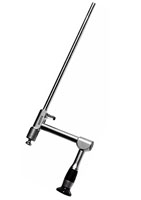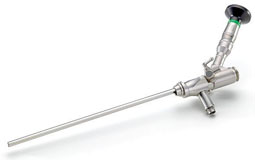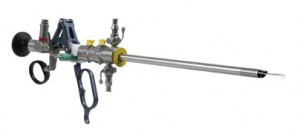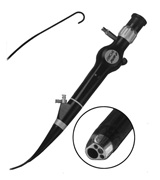Categories
Urology Equipment: Description of the Main Tools
Urology is one of the surgical specialties in the field of medicine. It focuses on conditions that affect the female and male urinary tract. Urologists also treat medical conditions that affect male reproductive organs. Professionals in this specialty encounter a wide range of clinical issues therefore they have to possess knowledge on gynecology, internal medicine and pediatrics. Urologists can specialize in pediatric urology, urologic oncology, renal transplantation, male infertility, urinary tract stones, female urology or neurology. Various instruments are used in the diagnosis, treatment, and management of urological conditions. Urology equipment has changed over the years as technology advances. Traditional procedures have improved with the introduction of new instruments. Here are some of the most common instruments used in this specialty.
Laparoscope
 A laparoscope is a thin endoscope, which is inserted into a patient’s body through an incision. The incision is often made in the stomach. This instrument allows an urologist to carry out minor surgery on a patient. It is also used to examine the organs in the abdomen. It looks like an ordinary tube but it is lighted. The laparoscope can identify fibroids, cysts, infections or adhesions in female patients. In most situations, the instrument is used as an alternative to laporotomy surgery, which is more extensive and requires larger incisions in the abdomen.
A laparoscope is a thin endoscope, which is inserted into a patient’s body through an incision. The incision is often made in the stomach. This instrument allows an urologist to carry out minor surgery on a patient. It is also used to examine the organs in the abdomen. It looks like an ordinary tube but it is lighted. The laparoscope can identify fibroids, cysts, infections or adhesions in female patients. In most situations, the instrument is used as an alternative to laporotomy surgery, which is more extensive and requires larger incisions in the abdomen.
Lithotripter
This is urological equipment, which applies sound waves on patients who suffer from kidney stones. The instrument helps to break the stones. It can be used for stones located in either the ureter or kidney. A lithotripter has several elements including a table that is helps to offer support when the patient is receiving treatment. This is a horizontal table where the patient is placed. It also has an overhead imaging device, which can be an ultrasound or x-ray machine.
Beneath the horizontal table is an electromagnetic shock wave emitter, which is designed to generate shock waves. These sound waves have to be passed through water to be effective. A water-filled cushion is wrapped around the patient to allow the sound waves to move. The table is adjustable therefore technicians can place patients at any angle in order to get a comprehensive image of the stones. This instrument directs the waves at the particular location of the stones. The imaging device allows technicians to observe the entire procedure in the kidney or ureter.
Nephroscope
This instrument is similar to a tube but it has a light source and it is inserted into insertions made into the renal pelvis. It is used to examine the kidney. The incision is made in a patient’s back in order to find kidney stones.
It can be compared to the lithotripter because it also helps to break the stones down. The instrument uses sound waves and once they are broken down, they can be eliminated through the tube. It is also used for diagnosis and ultrasound litholapaxy. The instrument can be used in both adults and children.
Resectoscope
The instrument is widely used during surgery to get rid of tissue from the urethra, bladder, prostrate or uterus. It is one of the many types of endoscope. It has a camera therefore urologists can use it to locate different parts of the internal organs. The instrument can also be used to carry out surgery. It is considered an effective alternative to traditional surgical equipment because it helps to lower surgical trauma. The instrument also helps to reduce healing time and it allows for minimal invasive treatment. It has a microscope, which makes it easy for surgeons to view an entire surgical site. This microscope offers a variety of angles therefore it is easy to view different sections of the patient’s body. It also comes with a loop made of wire. This loop is electrically activated and this is helpful in the removal of unwanted tissue. The loop has been designed to cauterize the area it removes tissue from and this limits bleeding during surgery or diagnostic tests. This also makes it unnecessary for the patient to undergo stitching after the procedure.
In situations where an urologist wants to examine the prostrate, bladder, or urethra, they can insert the resectoscope via the urethra. For examination of the uterus, this instrument is inserted via the vagina. Incisions made in the belly can also be used to allow doctors to examine the uterus. It is a very small instrument therefore urologists do not have to make large incisions. The site of the incision for insertion can vary depending on the doctors’ or patient’s preference.
Ureteroscope
This device is used to examine the urinary tract. It is used to perform ureteroscopies, which are important for the identification and removal of kidney stones. One of the main advantages of this instrument is that an insertion is not necessary. This makes it one of the least invasive endoscopes. It also helps to reduce the infection risks for patients. It is inserted via the urethra and the physician directs it through the bladder to the ureter until it gets to the kidneys. A large number of kidney stones are found in the kidneys but some of them can also be found in the urethra, bladder or ureter. A basket is attached to the end of the ureteroscope to hold the kidney stones that are eliminated.
Ureteroscopes are available in two main forms. Some of them are rigid and are similar to telescopes. These rigid ones come in handy when a urologist wants to navigate through the urethra in a straight line. This type of instruments is used to find stones in the lower sections of the ureter especially close to the bladder. Other instruments are flexible and this allows doctors to make turns when they are navigating through a patient’s body. The flexible ureteroscopes are used to find and remove stones inside the kidney. They can also be used if the stones are close to the ureter. Flexible ones offer better comfort for patients because doctors can manipulate them.
There is a wide range of urological equipment and each one is used to diagnose or surgically medical conditions that affect the kidneys, bladder, ureter, and urethra.







